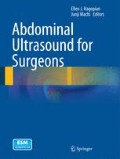Abstract
Abdominal ultrasound is one of the most commonly used imaging methods currently. It is different from other imaging such as computed tomography because surgeons (especially abdominal surgeons, hepatobiliary pancreatic surgeons, surgical oncologists, and minimally invasive surgeons) can and should perform ultrasound examination by themselves.
Abdominal ultrasound, including transabdominal ultrasound, intraoperative ultrasound, laparoscopic ultrasound, and endoscopic ultrasound, can provide various types of diagnostic information which are otherwise not easily or practically available. In addition, ultrasound can guide or assist various surgical procedures such as needle biopsy and ablation of lesions in real time much easier than other imaging methods. Advantages of transabdominal, intraoperative, and laparoscopic ultrasound include high accuracy, safety, and speed, with comprehensive anatomical information, dynamic blood flow information, and real-time guidance capability, and these outweigh its disadvantages such as specific instrumentation requirement and slow learning curve.
History of the use of ultrasound by surgeons, future perspective of surgeon-performed ultrasound, learning of abdominal ultrasound in future, and new and promising technology in abdominal ultrasound (including video clips) are described in this chapter.
The use of abdominal ultrasound by surgeons is expected to increase along with more formal training in ultrasound for surgeons. New ultrasound technologies such as ultrasound contrast enhancement, 3/4-dimensional ultrasound, fusion technique, elastic imaging, and quantitative ultrasound will be employed more during future abdominal ultrasound and will facilitate interventional procedures. Being like the surgeon’s stethoscope and versatile transabdominally and intraoperatively, ultrasound is a valuable technique which is recommended to master for surgeons in various fields to improve surgical decision-making and surgical outcomes.
Access this chapter
Tax calculation will be finalised at checkout
Purchases are for personal use only
References
Mitsunori Y, Tanaka S, Nakamura N, Ban D, et al. Contrast-enhanced intraoperative ultrasound for hepatocellular carcinoma: high sensitivity of diagnosis and therapeutic impact. J Hepatobiliary Pancreat Sci. 2013;20:234–42. Published online: 08 March 2012.
Arita J, Takahashi M, Hata S, Shindoh J, Beck Y, Sugawara Y, et al. Usefulness of contrast-enhanced intraoperative ultrasound using Sonazoid in patients with hepatocellular carcinoma. Ann Surg. 2011;254:992–9.
Ophir J, Céspedes I, Ponnekanti H, et al. Elastography: a quantitative method for imaging the elasticity of biological tissues. Ultrason Imaging. 1991;13:111–34.
Itoh A, Ueno E, Tohno E, et al. Breast disease: clinical application of US elastography for diagnosis. Radiology. 2006;239(2):341–50.
Fischer T, Peisker U, Fiedor S, et al. Significant differentiation of focal breast lesions: raw data-based calculation of strain ratio. Ultraschall in der Medizin. 2012;33(4):372–9.
Tanter M, Bercoff J, Athanasiou A, et al. Quantitative assessment of breast lesion viscoelasticity: initial clinical results using supersonic shear wave imaging. Ultrasound Med Biol. 2008;34:1373–86.
Lizzi FL, Greenebaum M, Feleppa EJ, Elbaum M, Coleman DJ. Theoretical framework for spectrum analysis in ultrasonic tissue characterization. J Acoust Soc Am. 1983;73:1366–73.
Mamou J, Coron A, Hata M, Machi J, Yanagihara E, Laugier P, Feleppa EJ. Three-dimensional high-frequency characterization of cancerous lymph nodes. Ultrasound Med Biol. 2010;36:361–75.
Mamou J, Coron A, Oelze M, Saegusa-Beecroft E, Hata M, Lee P, Machi J, Yanagihara E, Laugier P, Feleppa EJ. Three-dimensional high-frequency backscatter and envelope quantification of cancerous human lymph nodes. Ultrasound Med Biol. 2011;37:345–57.
Saegusa-Beecroft E, Machi J, Mamou J, Hata M, Coron A, Yanagihara E, Yamaguchi T, Oelze M, Laugier P, Feleppa E. 3D quantitative ultrasound for detecting lymph-node metastases. J Surg Res. 2013;183:258–69.
Author information
Authors and Affiliations
Corresponding author
Editor information
Editors and Affiliations
Electronic Supplementary Material
Below is the link to the electronic supplementary material.
IOUS image of multinodular HCC (hepatoma) and a section of corresponding area of a resected specimen (AVI 2,953 kb)
IOUS image showing thread and streak sign in vascular MFI (micro-flow imaging) (AVI 3,365 kb)
Three planes of 3D and MPR (multi-planar reconstruction) display method in CEUS (AVI 3,030 kb)
Multiview method (example of A-plane display): many slice images. Videos shows A-plane (AVI 5,526 kb)
Multiview method (example of A-plane display): many slice images. Videos shows B-plane (AVI 3,559 kb)
Multiview method (example of A-plane display): many slice images. Videos shows C-plane (AVI 2,921 kb)
Cavity display in IOUS Kupffer imaging of metastases (AVI 421 kb)
HV FlyThru display of HCC and portal and hepatic veins (AVI 4,637 kb)
PV FlyThru display of HCC and portal and hepatic veins (AVI 6,723 kb)
Fusion. CTA vs. CEUS (Sonazoid®) (AVI 39,146 kb)
Fusion. CTA vs. RFA (RITATM) puncture (AVI 45,,995 kb)
Rights and permissions
Copyright information
© 2014 Springer Science+Business Media New York
About this chapter
Cite this chapter
Machi, J., Moriyasu, F., Arii, S., Yano, M., Saegusa-Beecroft, E. (2014). Future Perspective in Abdominal Ultrasound. In: Hagopian, E., Machi, J. (eds) Abdominal Ultrasound for Surgeons. Springer, New York, NY. https://doi.org/10.1007/978-1-4614-9599-4_23
Download citation
DOI: https://doi.org/10.1007/978-1-4614-9599-4_23
Published:
Publisher Name: Springer, New York, NY
Print ISBN: 978-1-4614-9598-7
Online ISBN: 978-1-4614-9599-4
eBook Packages: MedicineMedicine (R0)

